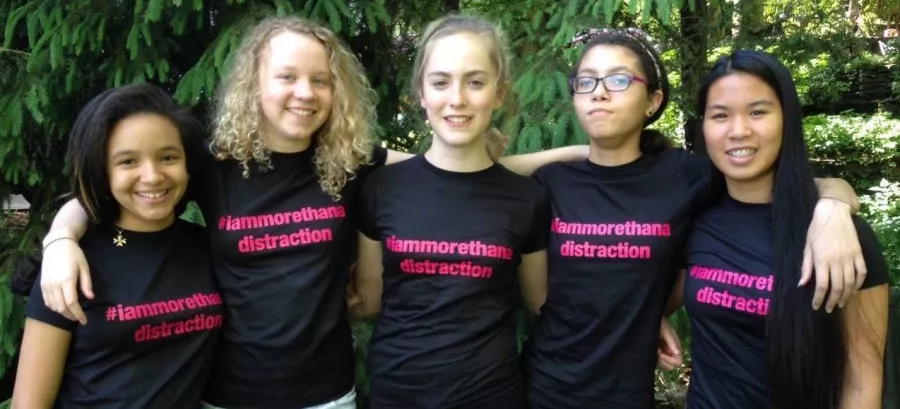In 2014, a group of middle school students in Maplewood-South Orange, New Jersey, started the hashtag campaign, #IAmMoreThanADistraction, to call attention to their school’s dress code.
Last year, Anna Loisa Cruz, a seventh-grader at Irvington School in Portland, Ore., was among four students who testified before the Portland Public Schools Board of Education to talk about school dress codes. She shared the story of one of her schoolmates who was “dress coded” for wearing a skirt that fell a couple of centimeters above her fingertips when holding her arms by her sides. The student was sent to the office where repeated calls to her home went unanswered. After a two-hour wait, the student went home, too embarrassed to return to her last period class.
Eighth-grade student Hailey Tjensvold added that school dress codes "have unknowingly set up double standards, creating a separation in the application of the punishment for [violating] the dress code.” She explained how boys whose trousers sag are simply told to “pull your pants up” without further repercussion while girls are sent to the office and “forced” to call their parents to bring them a change of clothes.
For many students across the nation—particularly girls—how school dress codes are enforced has been a contentious issue. In April 2015, a Texas honors student was sent home for wearing yoga pants and an oversized shirt that covered her entire backside. In August, a Kentucky student was sent home for showing her collarbone. After her mother brought a scarf to cover her neck, the administration still deemed it “inappropriate.” In Indiana, a 12-year-old student was suspended and missed two days of class. The offense: tight pants. Other dress-code violations include baring shoulders, wearing a tank top, or exposing a bra strap.
The Portland students represent only one group of a growing number of students who are spotlighting unfair and discriminatory school dress codes. In 2014, New Jersey middle-schoolers, fed up with being shamed for wearing comfortable clothes during warmer weather, launched a campaign under the Twitter hashtag #IAmMoreThanADistraction to challenge schools to focus their attention on reducing objectification of the female body.
Maggie Sunseri, a high school student at Woodford County High School in Versailles, Kentucky, produced “Shame: A Documentary on School Dress Code.” The film features several female students who talk about the challenges they face with school dress codes.
One of the students shares how it’s hard to find clothes that comply with the dress code. “I had bought a crew-neck shirt and it came right here [pointing to her collarbone]…I was told that it was ‘pushing the line.’”
Video: Oregon Students on Discriminatory Dress Codes
NEA Today asked educators on Facebook if they see girls being unfairly targeted over student dress codes. Most of the responses indicated some degree of support for dress code policies. “Business casual or uniforms,” responded Margarette Ellen Allen. “I’m sorry but there it is. When they head off to the ‘real world’…that will be the expectation in basically any job setting—be it blue collar or white collar.”
Marci Farran Kutzer agreed, but added another element to the dress code policy, and that’s language. “I think dress codes should exist, as a way to note that school is a professional learning space and deserves respect.…As long as the language of the policies focuses on professionalism and high expectations for learning, and stays away from asking for modesty, all is good. When kids are told to be ‘modest,’ we are sexualizing their wardrobes, and why are we doing that children?”
Sending the right message to students is important. Otherwise, says one of the Kentucky students in “Shame," “It sends the message to boys that it’s all girls' fault.…It wasn’t their fault that they were staring—it’s the girls' fault,” she said.
In November, however, Maggie Sunseri's efforts paid off. Woodford High agreed to update its 11-year-old policy to include changes suggested by students. It will now be appropriate to show a collarbone, as long as the neckline doesn’t drop “lower than the shortest dimension of a credit card”—that’s about 2.1 inches. The revised policy went into effect in January. Sunseri told the Lexington Herald Leader that students were "excited that we're getting a more lenient code."
This is the kind of outcome the students in Portland would like to see. “What we want is the district to form a committee with students, parents, teachers, and administrators to revise the dress code. We need to change the language and policies so the dress code is fair and non-discriminatory to all students,” said Sofia Carlson, a student at Irvington School. “In the 1800s it was scandalous to show your ankles. In the '50s it was scandalous to wear pants. We think now…modernizing the dress code is a small step of a bigger issue.”
Photo: iammorethanadistraction Facebook


